How to Create Personalized Experiences Through Marketing Automation — NOT a Catch-22 Situation


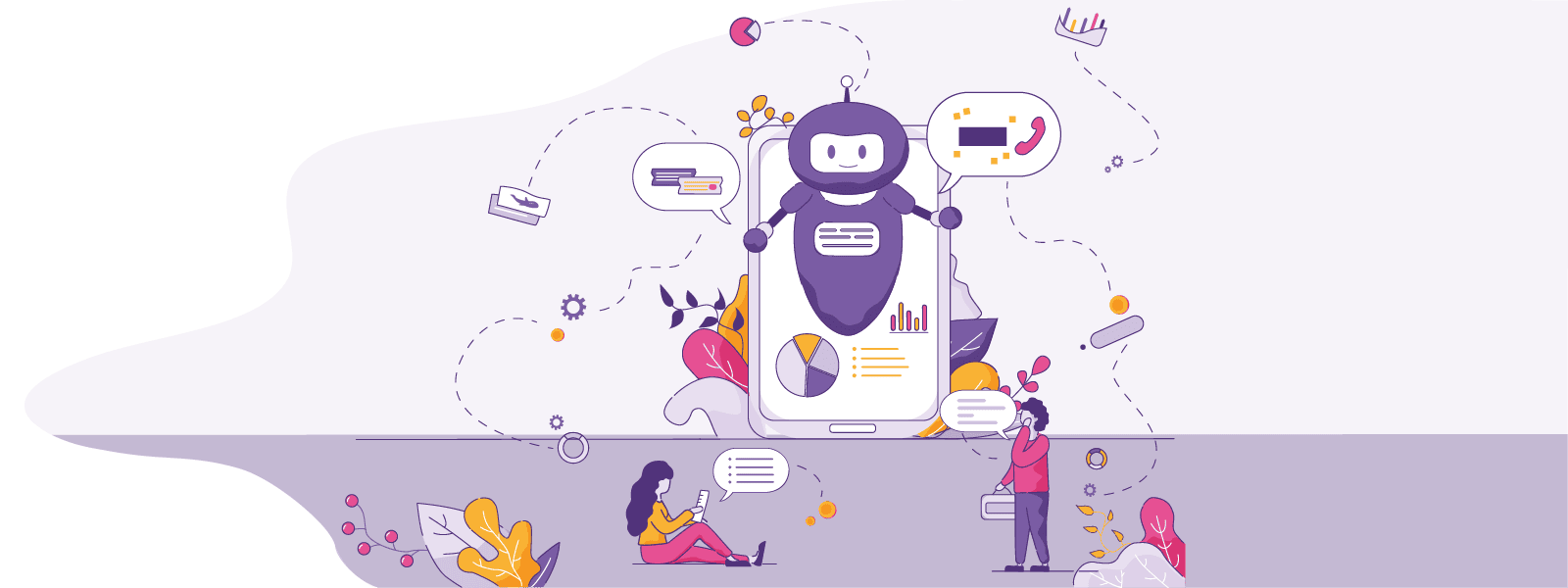
According to a Gartner survey, companies will be competing mostly on a customer experience basis by 2020.
To offer great customer experience, companies must first and foremost provide personalization.
The kind of personalization that gives the consumer a genuine interaction and meets their requirements at every touchpoint. Failure to provide a personalized experience makes the consumers switch brands.
So, why is personalization important to your business?
Well, personalization allows your business to engage its customers throughout the sales cycle with tailored content that meets the specific customer’s needs and objectives.
It provides your business with insights that can significantly improve its operations. It also improves business processes and customer support and leads to increased conversions across channels.
Personalization helps your business stand out from the competition.
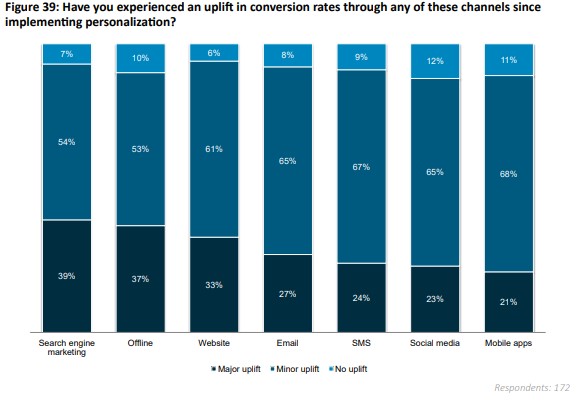
Image Source: Red Eye Optimization
When done right, personalization leads to increased engagement, enhanced customer experiences, and loyalty. As a marketer, you can deliver the right messages and anticipate what your customer wants.
The benefits of personalization spread to the marketer too.
Let’s look at some numbers, shall we?
Your company gets a 50 percent reduction in acquisition cost, a 10-30 percent increase in marketing spend efficiency, and 5-15 percent revenue increase.
Interesting, right?
However, this kind of personalization can only happen if you and your team understand and know the customer well.
For a business with few clients, the process can happen easily as one can manage their data personally. However, as the business grows, it becomes hard to keep up with the different changes in data and the increasing data from new customers.
That is where automation comes into play.
Automation uses software to automate marketing activities. Pretty straightforward, right?
But here’s the one objection to automation we hear most often: how can an AUTOMATED action be PERSONALIZED?
Sounds like a Catch-22, right?
Well, it’s not. Not exactly.
We’re actually in the business of proving this.
Our customers put some of their business operations on auto-pilot through our integration solutions and reap the benefits of less menial work, and more importantly, better, more effective personalization.
Intrigued?
Bear with us while we start with the basics.
Software like AI marketing tools for business facilitates the management of contacts, leads, campaigns, and the impact your business has. It helps you segment customers into categories.
With segmentation, you can then provide customized and tailored content to your customers with ease. You can meet each customer’s expectations effectively.
It helps you understand what they want and gain insights into how to move them from a qualified lead to a conversion and a loyal customer.
Automation allows you to personalize email marketing, social media, and SMS marketing. It allows your marketing team to provide the right message to the consumer at the right time using the right channel.
Sixty-seven percent of marketers are currently using some automation in their marketing strategy. Some of the benefits to automation include improved message targeting, improved customer experience, good quality leads, and improved efficiency.

Image Source: Email Monday
Personalized experiences through marketing automation
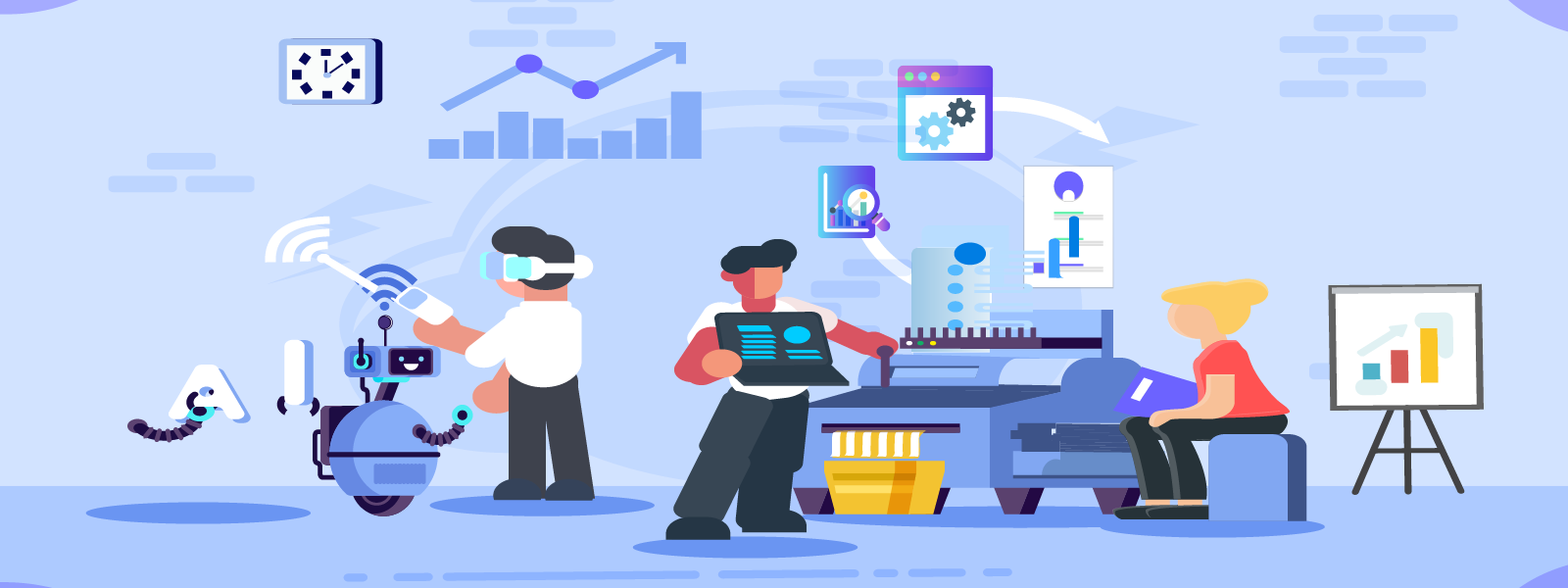
Consumers demand and expect companies to understand their needs and priorities. According to research, 63 percent of consumers expect personalized service, while 61 percent assume companies have their information at their fingertips.
Fifty-four percent want a brand to know their buying habits and preferences and use them to anticipate their needs.
Most consumers identify specific actions, such as receiving special offers from you as a form of personalization.
When companies deliver personalized experiences, customers become loyal. Thirty-seven percent, according to the same research, say they will likely buy from brands that personalize their experiences in the future.

Image Source: RedPoint Global
This level of personalization requires automation. This will enable your businesses to interact with many customers and prospects personally.
Ninety percent of consumers are also willing to share their data to get a cheaper and easier shopping experience.
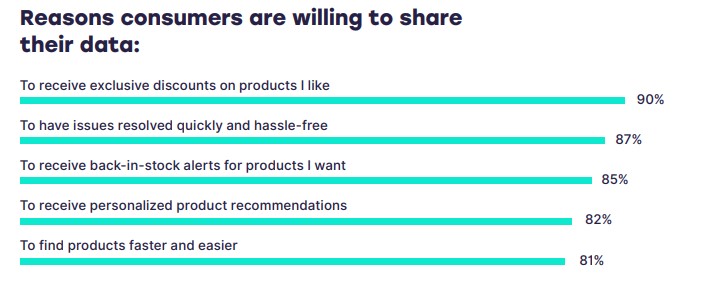
Image Source: Smarter HQ
The Catch-22 Situation: Personalization and Automation
Human beings are complex because the same 90 percent willing to share their data to get personalized experiences find some personalization tactics somewhat creepy.
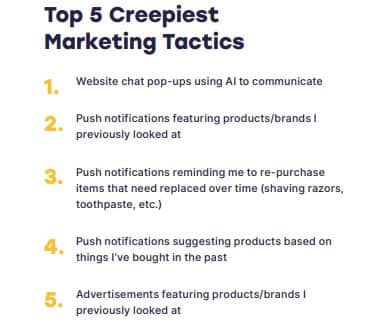
Image Source: Smarter HQ
Push notifications are considered the creepiest at 74 percent compared to other channels. Consumers feel like brands are stalking them. They do not want random messages, especially when they are not on a website.
The consumer wants the brands to provide personalized experiences through understanding them better, but they also want the same brands to know when to leave them alone. They need their personal space respected.
It’s a Catch-22 situation. How do you provide personalized experiences without being creepy?
Sixty-three percent of consumers will stop buying from brands that employ poor personalization tactics. Sixty-eight percent will tell their friends about it, 33 percent will complain about it on social media, while 41 percent will post a negative review.

Image Source: Smarter HQ
Consumers will be unwilling to engage with your brand if you cannot find a balance between personalization and automation. Design your personalization efforts in a way that makes it easier for consumers to shop and give them smoother experiences.
The tactics you use to personalize shopping experiences should not be invasive. They should be helpful. You need to know how to be helpful without invading their personal space. It’s important to show your customers that they can trust you with their data.
According to research, marketers are also concerned about personalization, even with automation. Sixty-three percent of marketers are afraid of the lack of personal connection and the risk of harming their businesses.
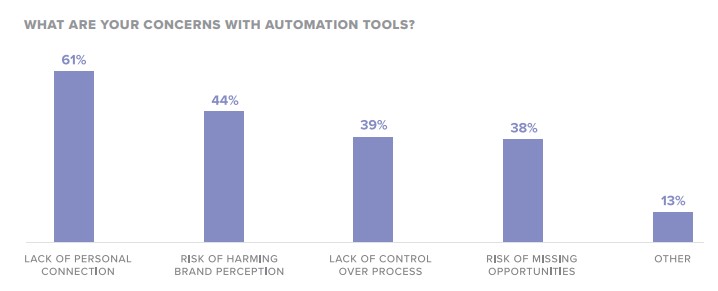
Image Source: Social Media Today
There needs to be a link that connects and strengthens your bond with your audience. If you are not actively monitoring their progress through the sales funnel, then you may harm your brand perception.
Marketers are happy with the ability of automation to connect them with the right people, but relying solely on this becomes a problem.
Their key concern is whether automation can be relied upon to “speak” to the potential audiences to maximize these lead opportunities.
Although automation helps you personalize communication, your team needs to provide the “human touch.” Automation does not happen on auto-pilot. It is not the leave-and forget kind of marketing solution.
It’s the facilitator that helps you provide personalized experiences. Relying too much on automation reduces personalization.
Viewing customers in terms of data makes your marketing impersonal. However, using the insights you get from this data can transform your business.
To be a successful marketer, you need to find a balance between the two so that the efficiency automation offers does not get lost when you are personalizing experiences.
As with everything in both life and business, balance is key.
Let’s see how to achieve it.
Creating Personalized Experiences through Marketing Automation
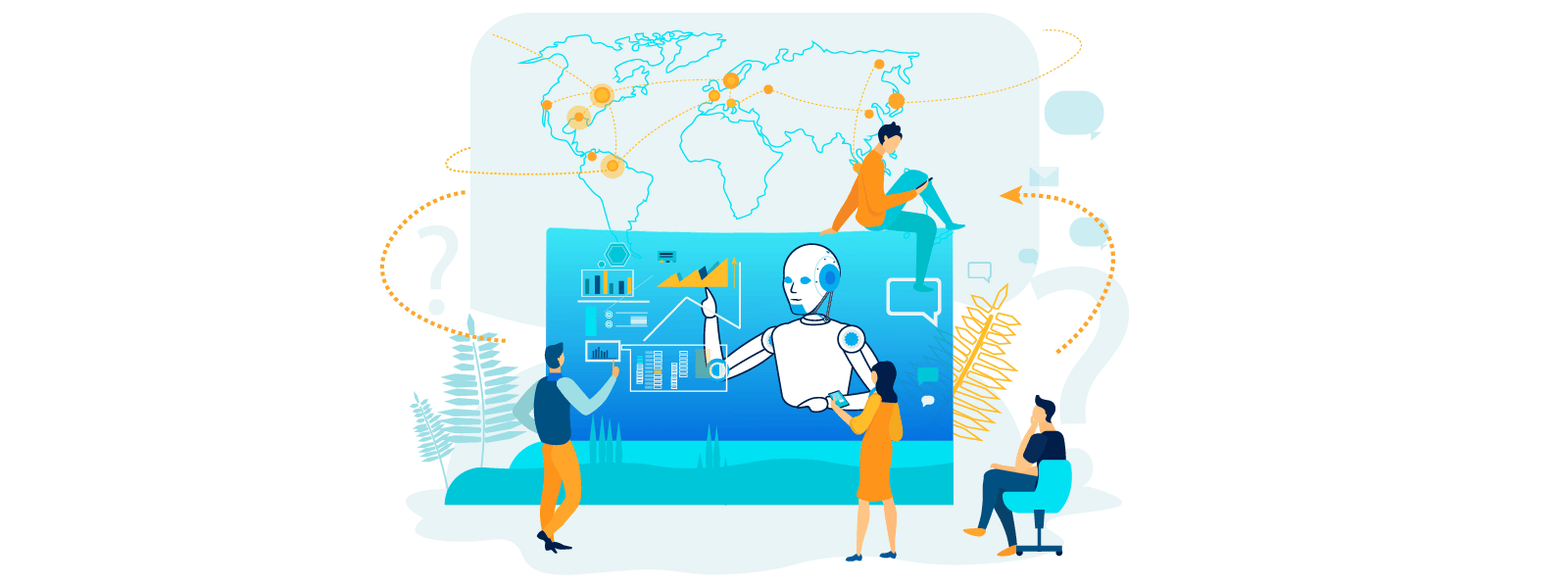
The following are ways you can create personalized experiences for your customers using automation. BUT without being creepy.
1. Enhance customer experiences
Automation helps you to leverage data to create better customer experiences. Your audience gets consistent and targeted messaging that is relevant and provides value. This personalization leads to better conversions, satisfied and loyal customers, and competitive advantage.
Using automation to create personalized experiences will require you not to eliminate the human touch. It does do most of the heavy lifting so that your team has more time to do what they do best – marketing, sales, product development, and customer care.
It provides you with an opportunity to create seamless experiences for customers who actively engage with your brand. In the process, you provide the products, services, information, and make it easy for them to access them.
Automation allows you to be available to the customer across all channels. You become available at every touchpoint, not just with automated messages but in person. Businesses that understand this will always succeed.
Make use of marketing automation tools to collect data and provide insights. You get a complete view of the customer interactions with your brand. This information empowers your team to make data-driven decisions.
With insights gathered, you can reach out to the customer, answer their queries in real-time, listen to their feedback, and provide seamless experiences across all channels and devices. You will also be in a better position to provide personalized experiences for each customer.
You can tune in to what your customers are saying from different channels. You gain access to online reviews in real-time, survey responses, and social media posts. It gives you the ability to monitor, analyze, listen, and improve interactions with customers. When tuned in to your customers, you can offer them improved services.
Customized experiences make the customer feel valued. These personalized efforts increase retention and loyalty.
2. Improve customer segmentation
Automation makes it easy to segment audiences beyond demographics. You get data on their browsing history on your website, their interests, buying habits, income, social media activity, and so much more. This information allows you to personalize communication with your audience.
Since automation frees up your time, use it wisely to place tags on prospects’ names so that messages feel intended for them.
After purchase, follow up with the customer to inquire about satisfaction, whether they need help, and whether you can suggest other products. Keep the conversation going, build a relationship, and occasionally avoid the generic thank you notes.
Data collected from segmentation helps you to make precise decisions in marketing. By knowing your customers’ preferences, you can tell what they expect to get once they arrive on your website or shop.
Use this information to tailor products and services to their specific needs so that they feel special. However, as we said, don’t get creepy.
Let’s say you own a coffee shop. Jane, a personal assistant, always gets a Café Latte, cappuccino, two doughnuts, and a burger every morning at 10.am.
From the customer history, you can see that Jane has always made the same order. So, the next day, when Jane comes in at 10, you have her morning coffee and accompaniments ready, so she doesn’t have to queue.
This will definitely make her day. This is an example of a highly personalized experience made possible by automation.
If you depended on human intuition, you might give her two doughnuts or maybe even give her a tea instead. Jane’s day is ruined!
So you see, data collected over time and automating certain tasks can make a customer feel valued and appreciated, thanks to a personalized experience.
3. Handle customer queries
Customers of today are interacting and shopping online, but they don’t want to do it alone. Eighty-three percent of shoppers expect to receive assistance immediately when shopping online. Otherwise, they abandon the purchase or head to a competitor site.
Fifty-seven percent of those who contact brands using social media expect a 60-minute response time during weekends (at night too!). The global economy also needs marketers to have 24/7 customer service to avoid losing business.
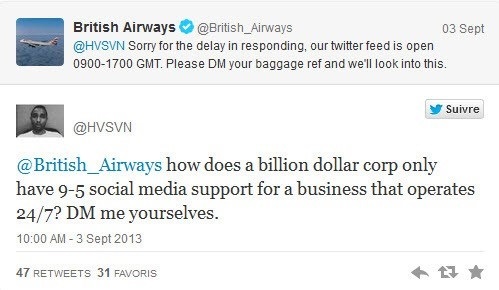
Image Source: Spokal
It’s becoming essential for businesses to have customer service chatbots to meet customer needs at any time of day. The chatbot market has seen tremendous growth and is estimated to be worth $1.34 billion by the year 2024.
Chatbots deliver personalized and immersive experiences at any time of the day on any channel your customers use to engage with your brand.
They help eliminate time spent waiting for an agent to be available for customers and frees up time for your agents. They allow you to be where your customers are all the time.
To improve personalization using chatbots, companies are employing Natural Language Processing. It allows chatbots to imitate conversational norms and use an emotive tone which is an acceptable substitute by customers for human interaction.
Companies are also using Interactive Voice Response to communicate with customers directly.

Image Source: My Customer
If used properly, chatbots are great for marketing and customer care. However, customers expect high efficiency, speed, and great experiences. Chatbots can not handle complex conversations, and this may lead to more harm to your reputation and brand.
The customer will get infuriated and abandon the conversation, but not before they share their frustrations online.
Still, chatbots are great when responding to Frequently Asked Questions because they free up time for the human agents. To make the experience personalized for the consumer, incorporate a live feature to enable agents and consumers to communicate.
The live chat feature enables the consumer to get even the most complex questions answered quickly. They get tailored support and engage in meaningful conversations as they move through the sales funnel.
According to research, consumers prefer to chat with someone while online rather than make a call. Allowing customers to speak via live chat meets their demands in real-time and gives you a competitive edge.
Live chat gives your company a 48 percent revenue increase per hour and a 40 percent increase in conversion rates.
Customers want to feel supported during their time of need – be it solving a problem or getting more information. Balancing both automation and personalization allows your team to make the customer feel supported through real conversations and a human touch.
4. Promotions and news updates
Providing relevant content to the right customer is made easier through marketing automation. It allows you to send customers targeted emails and adverts.
However, the level of personalization in this kind of content can get intrusive. Overpersonalizing can creep out the customer. The algorithms will provide you with the right data, but you have to pay attention to your target audience and to how certain messages will resonate with them.
Although consumers want brands to know them to provide personalized experiences, you may go too far with it. It’s good to respect customer privacy.
For example, avoid sending mass emails with the same offers because consumers vary in terms of interests and needs. You may end up offending clients. Case in point: the local mortuary that sent a man in assisted living a Christmas basket.
Before sending a suggestion or advert, consider whether the email sent will improve the relationship or make the customer feel uneasy.
Do not lose sight of the reason for personalization and alarm your customers. Instead, use customer data effectively to avoid creeping them out and ruining your brand’s reputation.
5. Offer valuable content
Automation allows you to send relevant content to customers. It allows you to segment the customers depending on their areas of interest and send them emails.
Email campaigns help you leverage personalization and automation. However, do not clog your audience inbox with emails. Instead, focus on providing value and relevant content.
Send them simple reminders based on their actions on your website. Did they abandon a cart?
Send them an email reminding them to finish the purchase and other products that may complement their items. To encourage conversion, offer incentives like free shipping or a discount if they buy before a given duration.
According to research, 40 percent of cart abandonment emails get opened, 50 percent of those opened get clicked on, and 50 percent of those who click make a purchase.
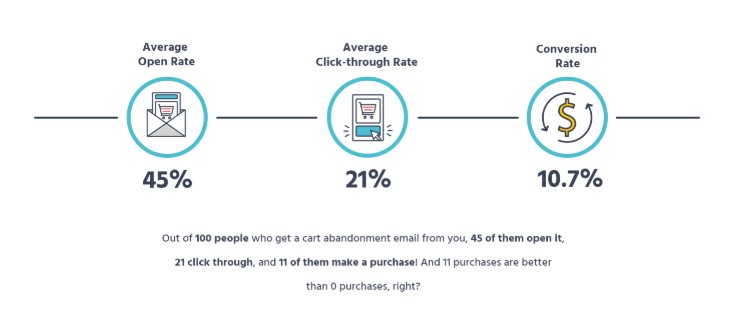
Image Source: Moosend
Abandoned cart emails help you get customers back to your site to complete a purchase. Such emails simply give the customer a polite nudge to complete their order.
Other reminders you can send include emails to customers who opened emails but didn’t click on the link. These are good for keeping the conversation going and the customer engaged.
6. Engage customers on-site
Automation and personalization help you engage anonymous visitors. You can personalize their web experience even without their contact information. Personalizing your website content reduces bounce rates, improves engagement, and encourages the customer to stay on the site and make a conversion.
Ensure that when a customer visits your site, they always get what they wanted. The landing page should not just have all the information they requested, but it should also be neatly arranged.
When the search engines direct the anonymous visitor to your site, you probably don’t have their email addresses. Personalizing their experience as they interact with your website helps you nurture them.
Make sure you personalize the content to their preference so that they can engage more with your site.
The website should respond to their actions. Recommend the most appropriate content to download or purchase, such as driving school resources, and in the process, get their contact information.
Provide timely offers based on their interactions with the site. You can even highlight or hide some of the content based on how the customer is navigating your site.
If they exit before making a purchase or downloading, have an exit pop up to entice them before they go.
Automation tracks their mouse, and when they are just about to leave, activates a pop-up encouraging sign up to an email list, a subscription to your blog, or an exclusive offer.
Have compelling call-to-actions that will convince them to make a conversion. You can offer a one-time discount, ask them to download a relevant document or sign up for a class.
However, do not flood the customer with pop-ups. They will close them before reading or switch to another search result. The pop-ups must also offer relevant content to what the customer is interested in or their history.
7. Up-sell and cross-sell
Predicting items a customer may be interested in is a great way to leverage personalization and automation. It helps you create a list of products or services a customer may be interested in based on previous purchases.
Customers feel a connection to the brand when it offers products that address their specific needs. Automated predictive analytics enable the prediction of shopping preferences based on customers’ past behaviors. This technology allows for personalized recommendations of items that complement previous purchases.
For instance, when a customer purchases dog food, the system automatically assigns them the dog tag and provides suggestions for their next visit to your site. Automated predictive purchasing enhances personalization.
8. Test continuously
Testing improves your personalization efforts. It’s also a good way to continuously learn from data and analytics. Test different communication methods across channels to see what messages are resonating with what audience.
What channel are the customers frequenting more?
How can you engage them more?
With the information gathered, ensure that you are offering your customers what they need and prefer.
More importantly, listen to customer feedback. Give them a say and learn from what they say. Engage them, continuously solve their issues, and meet their needs.
Conclusion

Automation offers data that helps with prediction and analysis, while personalization improves customer interactions. Automation shows you what customers are interested in and what they prefer. This information then enables you to personalize interactions with customers.
However, audiences are different, and you should treat them as such. Find a balance between automation and personalization.
Automation is a tool that will take your personalization efforts a notch higher. Overdoing it can make communication robotic and not personalized. People still require that human touch.
Regularly interact with your customers on social media, through emails and phone calls. Ensure you provide engaging content and keep the conversation alive and relevant by engaging customers on different channels.
Automation will provide technological solutions, but your team still needs to build relationships with your customers. However, they both offer you an opportunity to have meaningful conversations with your customers and improve their experiences.
Evaluate the best methods for sending messages, the channels to utilize, and the content to share. Ensure that communication with your target audience is engaging and neither robotic nor overly personalized. Prioritize the customer experience at every interaction.